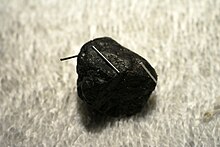Lodestone


Lodestones are naturally
Lodestone is one of only a very few minerals that is found naturally magnetized.
Origin
The process by which lodestone is created has long been an open question in geology. Only a small amount of the magnetite on the Earth is found magnetized as lodestone. Ordinary magnetite is attracted to a
The other question is how lodestones get
History
One of the earliest known references to lodestone's magnetic properties was made by 6th century BC Greek philosopher Thales of Miletus,[12] whom the ancient Greeks credited with discovering lodestone's attraction to iron and other lodestones.[13] The name magnet may come from lodestones found in Magnesia, Anatolia.[14]
The earliest Chinese literary reference to magnetism occurs in the 4th-century BC Book of the Devil Valley Master (Guiguzi).[15] In the chronicle Lüshi Chunqiu, from the 2nd century BC, it is explicitly stated that "the lodestone makes iron come or it attracts it."[16][17] The earliest mention of a needle's attraction appears in a work composed between 20 and 100 AD, the Lunheng (Balanced Inquiries): "A lodestone attracts a needle."[18] In the 2nd century BC, Chinese geomancers were experimenting with the magnetic properties of lodestone to make a "south-pointing spoon" for divination. When it is placed on a smooth bronze plate, the spoon would invariably rotate to a north–south axis.[19][20][21] While this has been shown to work, archaeologists have yet to discover an actual spoon made of magnetite in a Han tomb.[22]
Based on his discovery of an
"A century of research has pushed back the first mention of the magnetic compass in Europe to Alexander Neckam about +1190, followed soon afterwards by Guyot de Provins in +1205 and Jacques de Vitry in +1269. All other European claims have been excluded by detailed study..."[25]
Lodestones have frequently been displayed as valuable or prestigious objects. The Ashmolean Museum in Oxford contains a lodestone adorned with a gilt coronet that was donated by Mary Cavendish in 1756, possibly to secure her husband's appointment as Chancellor of Oxford University.[26] Isaac Newton's signet ring reportedly contained a lodestone which was capable of lifting more than 200 times its own weight.[27] And in 17th century London, the Royal Society displayed a 6-inch (15 cm) spherical lodestone (a terrella or 'little Earth'), which was used to illustrate the Earth's magnetic fields and the function of mariners' compasses.[28] One contemporary writer, the satirist Ned Ward, noted how the terrella "made a paper of Steel Filings prick up themselves one upon the back of another, that they stood pointing like the Bristles of a Hedge-Hog; and gave such Life and Merriment to a Parcel of Needles, that they danc'd [...] as if the devil were in them."[29]
References
- ^ ISBN 0-471-15677-9.
- ISBN 978-1862393158.
- ^ ISBN 0-387-22967-1.
- ^ Dill, J. Gregory (Jan–Feb 2003). "Lodestone and Needle: The rise of the magnetic compass". Ocean Navigator online. Navigator Publishing. Retrieved 2011-10-01.
- ISBN 0-12-491246-X.
- ISBN 0-521-31560-3.
- ^ "Lodestone". Merriam-Webster online dictionary. Merriam-Webster, Inc. 2009. Retrieved 2009-06-12.
- ^ "lodestone". Oxford English Dictionary (Online ed.). Oxford University Press. (Subscription or participating institution membership required.): 'Literally 'way-stone', from the use of the magnet in guiding mariners.'
- ^ ISBN 0674216458.
- ^ .
- ^ ISBN 978-0470976029.
- ^ Brand, Mike; Sharon Neaves; Emily Smith (1995). "Lodestone". Museum of Electricity and Magnetism, Mag Lab U. US National High Magnetic Field Laboratory. Archived from the original on 2009-05-01. Retrieved 2009-06-21.
- ISBN 0-7803-1193-0.
- Manisa, Turkey) or after the Greek region of Magnesia itself (whence came the colonist who founded the Lydian city); see, for example, "Magnet". Language Hat blog. 28 May 2005. Retrieved 22 March 2013. See also: Paul Hewitt, Conceptual Physics. 10th ed. (2006), p. 458.
- ^ The section "Fanying 2" (反應第二) of The Guiguzi: "其察言也,不失若磁石之取鍼,舌之取燔骨".
- ISBN 978-0415426992.
- S2CID 143585290.[...]: "La pierre d'aimant fait venir le fer ou elle l'attire."
un passage dans le Liu-che-tch'ouen-ts'ieou
From the section "Jingtong" (精通) of the "Almanac of the Last Autumn Month" (季秋紀): "慈石召鐵,或引之也]" - ^ In the section "A Last Word on Dragons" (亂龍篇 Luanlong) of the Lunheng: "Amber takes up straws, and a load-stone attracts needles" (頓牟掇芥,磁石引針).
- ^ Tom, K. S. (1989). Echoes from Old China: Life, Legends, and Lore of the Middle Kingdom. University of Hawaii Press. p. 108.
- ISBN 978-1592650200.
- ^ Curtis Wright, David (2001). The History of China: (The Greenwood Histories of the Modern Nations). Greenwood Publishing Group. p. 42.
- ^ Joseph Needham, Clerks and Craftsmen in China and the West: Lectures and Addresses on the History of Science and Technology. Cambridge: University Press, 1970, p. 241.
- ^ S2CID 33186517.
- ^ Evans, B. J., Magnetism and Archaeology: Magnetic Oxides in the First American Civilization, p. 1097, Elsevier, Physica B+C 86-88 (1977), S. 1091-1099
- ^ Needham, Clerks and Craftsmen, p. 240.
- ^ Kell, Patricia (1996). "Inv. 47759 - Sphaera article".
- ^ Thompson, Sylvanus (1891). The Electromagnet, and Electromagnetic Mechanism (PDF). London: E. & F. N. Spon. p. 128.
- ^ "A terella". The Royal Society Picture Library.
- ISBN 9780691634913.
